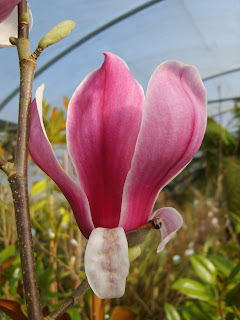“So I was using a neonicotinoid...”
In a short time I doubt I'll be saying
that again! At some point in the not-too-distant future the
insecticide group known as the neonicotinoid group will be banned
from use in Europe. This insecticidal group of chemicals makes up
about 25% of the European pesticide market, so there is a battle
being waged between the producers of this chemical group (who
predictably claim that the environmental effects of their products
are minimal) and anyone who understands the importance of beneficial
insects, including (most famously) bees. As the neonicotinoid group
is a broad spectrum insecticide it will kill any insect. Although the
doses and application rates are aimed at damaging populations of
small insects, it also has a knock-on effect on larger insects that
collect pollen and nectar from the flowers of treated plants,
including causing infertility and abnormalities in bees, and
subsequently population decline.
I'm not going to enter into the issues
around the neonicotinoid group here. I would like to draw your
attention to a product...
This is Intercept. It is a
neonicotinoid that is available solely to professionals who have a
pesticide handling certificate (usually a PA1/PA6). It is
manufactured by Scotts, who also make slow-release fertilisers,
“Miracle Grow”, and various insecticides and herbicides.
Now before you lobby to have all Scotts
products removed from sale because they [currently] make
neonicotinoids, I would like to draw your attention to the label.
On the side of the label it makes it
absolutely clear that this product must not be used on any edible
crops, or even compost that might be reused to grow crops for human
or animal consumption. Fair enough, it's poisonous and has a residual
effect. Let's look at the bottom of the label....
“HIGH RISK TO BEES. Do not apply to
crops in flower or to those in which bees are actively foraging. Do
not apply when flowering weeds are present.”
This particular bottle of Intercept was
bought in 2008 and has a clear warning that there is potential to
harm bees.
How does one company know that their
product is dangerous to bees warn users
while another (Bayer)
continues to maintain that neonicotinoids are not harmful?
Neonicotinoids will be banned from use.
Horticulture is better placed to cope with this than agriculture;
neonicotinoids have almost already been replaced by a bacterial
product to combat vine weevils in compost ('Met52') (as well as using
nematodes if needed later in the growing season), Integrated Pest
Management (IPM), better horticultural practices, and (if necessary)
the remaining chemical products available to professional growers.
At work we seldom spray any stock in
the tunnels or outdoors- birds and insects do most of the work for
us- and maybe the occasional isolated batch might need a chemical
treatment if a pest population is getting out of hand. We never
routinely 'blanket spray' plants, even though we grow an enormous
range and are always short on manpower- nature takes it's course and
we intervene only if absolutely necessary. Most hardy stock nurseries
run along similar lines.
So before I get a brick thrown through
my window... why was a using a neonicotinoid product when I know
about the dangers to bees? I had a very serious root aphid
infestation on the root-balls of some large Pinus roxburghii.
Ordinarily plants with such bad infestations of root pests would be
disposed of, but throwing away rare pines that are already more than
a decade old is not an option. Am I happy with my decision? Yes.
Pines are pollinated by the wind, not bees, and there is no chance of beneficial insects being harmed by the use of this product on the pine- I assessed the risks and
used the product legally. Once there is an effective drench for root
aphid on non-flowering plants then the little bottle of Intercept at
the back of the pesticide locker will become a thing of the past.
More likely we will run out of Intercept granules and then it will be
banned, but at least the Pinus roxburghii are safe.










